
The video explains how to convert a Word document to Braille using Duxbury with minimal effort.
- Subject:
- Education
- Educational Technology
- Material Type:
- Teaching/Learning Strategy
- Author:
- DAISY Consortium
- Date Added:
- 12/04/2023

The video explains how to convert a Word document to Braille using Duxbury with minimal effort.

The primary advantage of inclusive digital document is its ability to be comprehended by individuals who experience challenges with conventional printed materials. Such a document can be interpreted through different means like enlarged text, audio playback, or braille representation. These various formats can be accessed using devices such as smartphones, computers, MP3 players, DAISY players, or refreshable braille displays. Additionally, an accessible digital document can be transformed into a format that is suitable for variety of reading devices.

Le principal avantage d'un document numérique inclusif est sa capacité à être compris par les personnes qui rencontrent des difficultés avec les documents imprimés traditionnels. Un tel document peut être interprété par différents moyens tels que le texte agrandi, la lecture audio ou la représentation en braille. Ces différents formats sont accessibles à l'aide d'appareils tels que les smartphones, les ordinateurs, les lecteurs MP3, les lecteurs DAISY ou les afficheurs braille actualisables. En outre, un document numérique accessible peut être transformé en un format adapté à divers appareils de lecture.

This public speaking lesson focuses on presenting and conveying important information, details, facts, and opinions in a concise manner. This lesson presents several different real-world situations where students are asked to share their perspectives, experiences, and stories where they are to give supporting details and facts that are important to the context of different social interactions (talking with peers, colleagues, community, interviews, etc). With the creation of this lesson, different level options of technology integration are offered to allow for flexibility and modifications for this lesson to best serve various classrooms and their students (low tech, medium tech, and high tech options). This lesson will help students analyze a social interaction and/or topic and have them clearly and concisely give an authentic response.
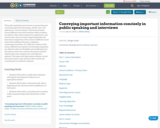
This public speaking lesson focuses on presenting and conveying important information, details, facts, and opinions in a concise manner. This lesson presents several different real-world situations where students are asked to share their perspectives, experiences, and stories where they are to give supporting details and facts that are important to the context of different social interactions (talking with peers, colleagues, community, interviews, etc). With the creation of this lesson, different level options of technology integration are offered to allow for flexibility and modifications for this lesson to best serve various classrooms and their students (low tech, medium tech, and high tech options). This lesson will help students analyze a social interaction and/or topic and have them clearly and concisely give an authentic response.
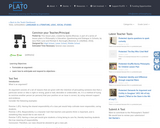
This lesson is designed to meet the following learning objectives:
1. Formulate an argument
2. Learn how to anticipate and respond to objections
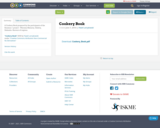
A Cookery Book prepared by the participants of the Erasmus + project - Warmia-Masuria, Umbria, Dalmatia -flavours of regions.
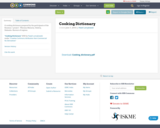
A cooking dictionary prepared by the participants of the Erasmus + project - Warmia-Masuria, Umbria, Dalmatia -flavours of regions.
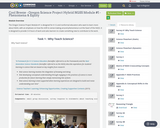
The Oregon Science Project Module #1 is designed for K-12 and nonformal educators who want to learn more about NGSS, with an emphasis on how the shift to sense-making around phenomena is at the heart of the NGSS. It is designed to provide 3-4 hours of work and asks learners to create something new to contribute to the work.
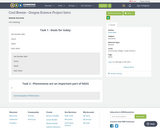
Intro Meeting

Coordinating Early Childhood Systems
Adults and a young child collaborating in an early learning classroom
While early childhood providers and families prioritize activities that optimize interactivity with peers and the natural environment, print and digital materials and technologies are commonly present in early learning settings, including the home and community. If and when they are determined to be appropriate, interactive materials and technologies need to be accessible if children with disabilities are to benefit from inclusive settings. Examples of accessible materials and technologies in early learning settings can include:
Tactile books that include a combination of print and braille
Video that includes captioning of sounds and audio description of visual elements
Mobile apps that are compatible with a child’s assistive technology (AT)
Ensuring that children with disabilities in early childhood programs can participate in all range of activities in early childhood programs is effectively achieved through a coordinated approach requiring collaboration between a number of agencies, federal, state, and local service providers, and families and caregivers.

Coordinating Higher Education Systems
Adults in a higher education environment collaborating
Multiple indicators show a positive trend in the number of students with disabilities enrolling in higher education programs. Equitable access to learning for these students requires that all learning materials and activities be made accessible to them. This extends to textbooks, courseware, learning management systems, instructional software programs—in short, any and all curriculum resources required for use in academic programs.
The Critical Components for the Quality Indicators for Higher Education were first released in 2018 and include actionable language for developing a coordinated system that leads to the timely provision of accessible materials and technologies in higher education settings for all students who need them.
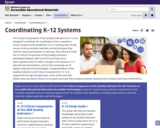
Coordinating K–12 Systems
Teachers collaborating in a K–12 environment
The Critical Components of the Quality Indicators for K-12 are designed to facilitate the coordination that is needed to ensure students with disabilities in K-12 settings have timely access to the accessible materials and technologies they need for equal participation in learning. They were the initial set of Critical Components of the Quality Indicators developed between 2007 and 2014 and have since been updated twice to reflect changes in the dynamic K-12 educational environment, such as the increasing use of digital materials and technologies. Implementation of the Quality Indicators and Critical Components for K-12 is supported through the AEM Pilot, a free online tool that allows state and district teams to set goals and track their progress toward creating more inclusive learning environments.
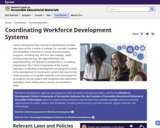
Coordinating Workforce Development Systems
Adults in a workplace environment collaborating
Career training and other workforce development activities take place across a variety of settings. For example, students with disabilities transition to a range of postsecondary programs, including two- and four-year colleges, career training programs (e.g., pre-apprenticeships and apprenticeships), and directly to employment or to seeking employment. The Critical Components of the Quality Indicators for Workforce Development are designed to assist in the development of coordinated systems that result in the timely provision of accessible materials and technologies for all students and job seekers with disabilities who need them, regardless of the setting where services are provided to them.

In this section, you and your team will engage in a Landscape Analysis to uncover key structures and supports that can guide your work to support Accessibility in OER. You may or may not answer all of these questions, but this is an offering.
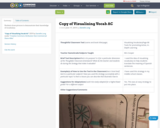
Students draw pictures to demonstrate their knowledge of vocabulary.
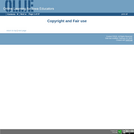
Copyright & Fair Use

This presentation provides an overview of Copyright Law and Creative Commons.

Short Description:
A quick reference guide to Canadian copyright law and how it impacts the use of digital teaching materials within higher education.
Long Description:
A quick reference guide to Canadian copyright law and how it impacts the use of digital teaching materials within higher education. We take a common sense approach in our quick types around use of various media formats within the teaching and learning environment. This guide is published under the Creative Commons Attribution 4.0 License.
Word Count: 8650
(Note: This resource's metadata has been created automatically as part of a bulk import process by reformatting and/or combining the information that the author initially provided. As a result, there may be errors in formatting.)

Performance Objectives: Understand the basics of copyright and fair use in relation to open educationImplement the Creative Commons Licenses Copyright. We know what it is. And that it is complicated. The digital world has drastically changed how we access, use and interact with copyrighted content.